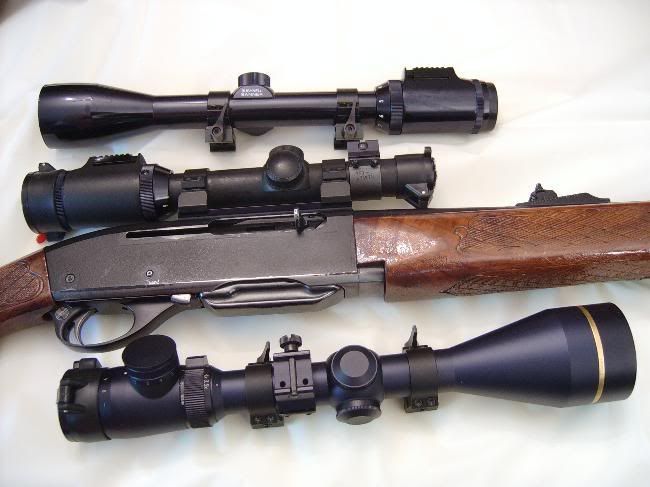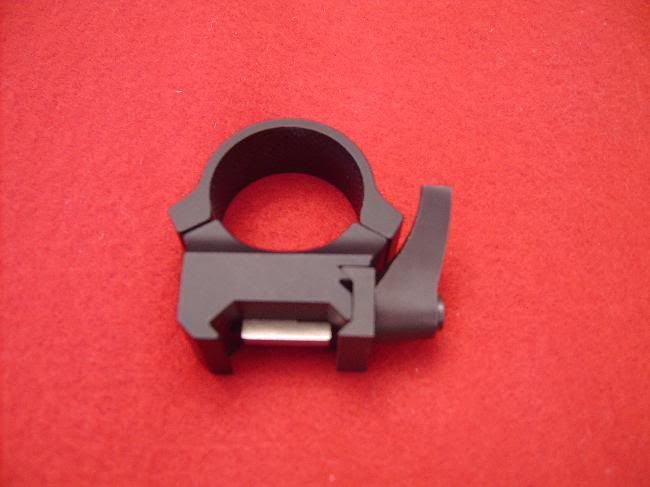Post by watchmaker on Oct 6, 2007 22:11:02 GMT -5
SCOPES
Hi guys,
I have been using scopes for forty years, and have had enough experience with them that I decided to post a few lines that may be of help to the new hunter.
My friends consider me a little extreme concerning optics and scopes in particular, since my hunting rifles usually have as many as three scopes.
That is right! And the reason for that is my fear of Murphy spoiling my hunt. You know what I mean, Murphy’s Law, "if something can go wrong it will?"
Also my motto concerning equipment is that two is one and one is none, so based on that premise my rifles have a spare pre-sighted scope and rings carried in the backpack.
Also, another scope of the total opposite magnification is also carried in the backpack to take care of those situations where the main scope will be too much or too little.
For example, in my Remington 742 in 30-06, I have a Bushnell 1 ½ to 6x Lite Site as a main scope when I hunt in Maine over bait for bears (at very short distance and the scope is kept at 1½x). The spare scope is a Bushnell 3x9 Lite Site, and the low light, long range scope is a Leupold Vary X III 3½ to 10x50 mm with an illuminated reticle. This scope was needed when a farmer spotted a big bear at the edge of a big field dining on clover.
THE REMINGTON 742 AND THE SCOPES

The outfitter switched me from the bait to this new location where the closest shot I will had was over 250 yards. Of course, the change in location makes the switch to the Leupold long range scope imperative, and also a change from the 30-06 180 grain round nose ammo I was using over the bait, to the ammo that I had sight in the long range scope, a spitzer 150 grains reload.
Another of my rifles that I plan to use in Alaska (when I get to go in my long-postponed trip for bear) is a RemingtonM-700 in 300 W.M.
It wears a 3x9 Leupold on Leupold Quick Detach Weaver style rings, and as a second scope, a Leupold Vary X III 1 ½ to 5 Illuminated reticle.
The spare scope is a Leupold Vary X II 1x to 4x with a heavy duplex, what is considered a shotgun scope. That way, if I have to go in the alders thickets looking for a wounded bear, I will have the right magnification in the 1x scope, plenty of field of view and also good eye relief for quick shooting.
Through the years I have used several mounts, all quick detachable. The mounts that I trust to take abuse more than any other are the Leupold Quick Detach Weaver style that can be mounted on Leupold Weaver bases, Weaver, or a Picattiny rail.
Weaver bases can be found for any rifle ever made, which make the system very versatile.
LEUPOLD QUICK DETACH WEAVER STYLE

I also use the Leupold Quick Detach system that uses a post in the ring to enter a hole in the base and is locked by turning a lever, a very elegant system and very good at preserving the point of impact without change after repeated removals.
In the past, I have used the Redfield JR or SR system complemented with the Pilkington Quick Detach lever. This worked very well for me in several rifles, if I took the precaution of case-harden the top of the front base and dove-tail of the front ring, to avoid excessive wear in repeated removals.
THE REDFIELD-PILKINGTON SYSTEM OF QUICK DETACH

If you think that having three scopes for each rifle is too much of a bother, just think of the benefits of having a long range scope when a long shot is needed or having one of low magnification when the terrain change into a close woods or jungle. Besides, you never knows when Mr. Murphy can surface, and make you drop your rifle in the rocks or fog your on-board scope.
I have had many scopes of many brands, with the exception of the high ticket European specialty scopes with big objectives. In my way of thinking, even though I like good optics, it is unnecessary to spend over a $1,000 for a scope for low light use, when most North American hunting is restricted to a ½ hour before sunrise and a ½ hour after sunset.
For me, the scope is the aiming system. It has to be reliable in the adjustment and takes recoil as well as be water and fog proof. The optics need to be good, but not necessarily the best of the best, as the real hunt, evaluation of the trophy, and study of the feasibility of the shot is usually done over a good pair of binoculars. The actual shooting and the looking trough the scope takes less than a minute, often very much less.
I am doing very well with the Leupold brand, as I trust their waterproof scopes and positive click adjustments that will not move under heavy recoil, but I have had good experiences with Bausch & Lomb scopes and Bushnell’s also, and I don’t have anything bad to say of the Tasco, Simmons, or other scopes I own.
Protecting the optics from dust and rain is very important. I rely mostly on Buttler Creek scope cover or the Bikini covers, and I sometimes cover them to protect their finish and guards from bumps with a Buttler Creek or Cabela’s Scope Cover, which is made of shock absorbing neoprene and will protect the scope during transportation or while in storage.
All the best,
Watchmaker
Hi guys,
I have been using scopes for forty years, and have had enough experience with them that I decided to post a few lines that may be of help to the new hunter.
My friends consider me a little extreme concerning optics and scopes in particular, since my hunting rifles usually have as many as three scopes.
That is right! And the reason for that is my fear of Murphy spoiling my hunt. You know what I mean, Murphy’s Law, "if something can go wrong it will?"
Also my motto concerning equipment is that two is one and one is none, so based on that premise my rifles have a spare pre-sighted scope and rings carried in the backpack.
Also, another scope of the total opposite magnification is also carried in the backpack to take care of those situations where the main scope will be too much or too little.
For example, in my Remington 742 in 30-06, I have a Bushnell 1 ½ to 6x Lite Site as a main scope when I hunt in Maine over bait for bears (at very short distance and the scope is kept at 1½x). The spare scope is a Bushnell 3x9 Lite Site, and the low light, long range scope is a Leupold Vary X III 3½ to 10x50 mm with an illuminated reticle. This scope was needed when a farmer spotted a big bear at the edge of a big field dining on clover.
THE REMINGTON 742 AND THE SCOPES

The outfitter switched me from the bait to this new location where the closest shot I will had was over 250 yards. Of course, the change in location makes the switch to the Leupold long range scope imperative, and also a change from the 30-06 180 grain round nose ammo I was using over the bait, to the ammo that I had sight in the long range scope, a spitzer 150 grains reload.
Another of my rifles that I plan to use in Alaska (when I get to go in my long-postponed trip for bear) is a RemingtonM-700 in 300 W.M.
It wears a 3x9 Leupold on Leupold Quick Detach Weaver style rings, and as a second scope, a Leupold Vary X III 1 ½ to 5 Illuminated reticle.
The spare scope is a Leupold Vary X II 1x to 4x with a heavy duplex, what is considered a shotgun scope. That way, if I have to go in the alders thickets looking for a wounded bear, I will have the right magnification in the 1x scope, plenty of field of view and also good eye relief for quick shooting.
Through the years I have used several mounts, all quick detachable. The mounts that I trust to take abuse more than any other are the Leupold Quick Detach Weaver style that can be mounted on Leupold Weaver bases, Weaver, or a Picattiny rail.
Weaver bases can be found for any rifle ever made, which make the system very versatile.
LEUPOLD QUICK DETACH WEAVER STYLE

I also use the Leupold Quick Detach system that uses a post in the ring to enter a hole in the base and is locked by turning a lever, a very elegant system and very good at preserving the point of impact without change after repeated removals.
In the past, I have used the Redfield JR or SR system complemented with the Pilkington Quick Detach lever. This worked very well for me in several rifles, if I took the precaution of case-harden the top of the front base and dove-tail of the front ring, to avoid excessive wear in repeated removals.
THE REDFIELD-PILKINGTON SYSTEM OF QUICK DETACH

If you think that having three scopes for each rifle is too much of a bother, just think of the benefits of having a long range scope when a long shot is needed or having one of low magnification when the terrain change into a close woods or jungle. Besides, you never knows when Mr. Murphy can surface, and make you drop your rifle in the rocks or fog your on-board scope.
I have had many scopes of many brands, with the exception of the high ticket European specialty scopes with big objectives. In my way of thinking, even though I like good optics, it is unnecessary to spend over a $1,000 for a scope for low light use, when most North American hunting is restricted to a ½ hour before sunrise and a ½ hour after sunset.
For me, the scope is the aiming system. It has to be reliable in the adjustment and takes recoil as well as be water and fog proof. The optics need to be good, but not necessarily the best of the best, as the real hunt, evaluation of the trophy, and study of the feasibility of the shot is usually done over a good pair of binoculars. The actual shooting and the looking trough the scope takes less than a minute, often very much less.
I am doing very well with the Leupold brand, as I trust their waterproof scopes and positive click adjustments that will not move under heavy recoil, but I have had good experiences with Bausch & Lomb scopes and Bushnell’s also, and I don’t have anything bad to say of the Tasco, Simmons, or other scopes I own.
Protecting the optics from dust and rain is very important. I rely mostly on Buttler Creek scope cover or the Bikini covers, and I sometimes cover them to protect their finish and guards from bumps with a Buttler Creek or Cabela’s Scope Cover, which is made of shock absorbing neoprene and will protect the scope during transportation or while in storage.
All the best,
Watchmaker



